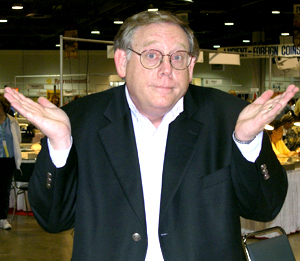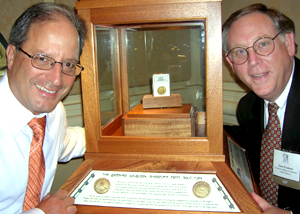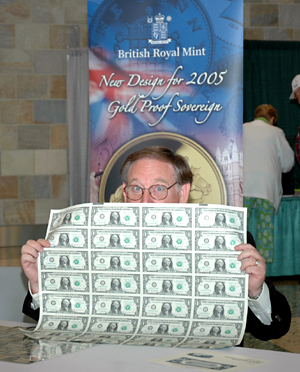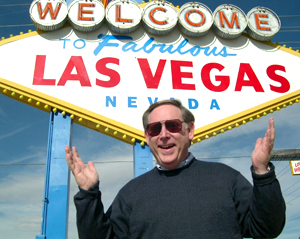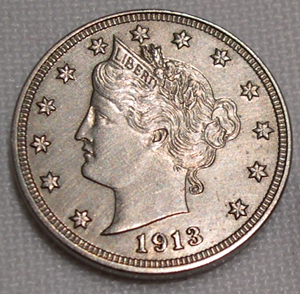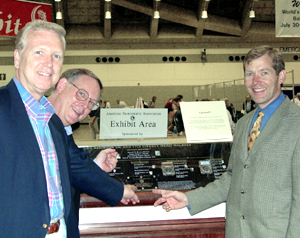He Spreads the News
By Leon Worden
October 2006
|
| D |
Stashed away in Fort Knox after being seized from a Philadelphia family in August 2005, the cache of contraband $20 gold coins was to come out of hiding for the first time in history.
Pearlman hadn’t been this excited since 2003, when one of his ideas for promoting the ANA convention in Baltimore led to the miraculous rediscovery of a coin that had been missing for 41 years. More on that later.
Now Pearlman had work to do. He’d already mailed 50 press kits touting all of the fun stuff to see and do in Denver — sans the last-minute Mint exhibit that now reduced some of America’s other great rarities to the status of "everything else."
"When I heard that this might come to pass, I started thinking about whom to notify," Pearlman said. "Of course the Denver news media; I also wanted to notify The Associated Press in Philadelphia because they had written a story when the Mint announced that it had these 10 coins a year ago. And I wanted to make sure that the numismatic hobby trade press was made aware of it."
Within hours, the story had made The Associated Press news wire. Pearlman wouldn’t go back and try to change the press kits; The Denver Post had already carried a pre-convention story with information about the Bureau of Engraving and Printing’s $1 billion money display and the Smithsonian Institution’s new traveling exhibit that was debuting in Denver. Changing the "message" would only confuse general-circulation newspaper and television reporters, Pearlman reasoned. Instead, the day before the convention was to open Aug. 16, he’d get on the phone and remind the media of this first-ever opportunity to see the fabled 1933 double eagles.
A Nose for News
No, Donn Pearlman isn’t the ANA’s staff "PR guy." An ex-ANA board member, Pearlman is a public relations specialist who has been under contract with the ANA since 1997 to help promote the association’s National Money Show in the spring and its World’s Fair of Money convention in the summer.
He also handles PR for three Long Beach Coin, Stamp and Collectibles expos each year, two shows in Santa Clara, Calif., and he helps promote individual numismatic items for prominent auction houses and dealers, such as Steven Contursi’s King of Siam proof set, Contursi’s 1794 Flowing Hair dollar (believed to be the first U.S. silver dollar) and his 1787 Brasher Doubloon with eagle on breast — true standouts in the pile of "everything else" in Denver.
|
"He saves my bacon," said Jay Beeton, who is the ANA’s staff PR guy. "He’s a rare breed because there is really nobody else in this field with his level of expertise in numismatics and professionalism in public relations."
Adds Gail Baker, the ANA’s manager of market and brand development: "It’s such a pleasure to work with somebody in PR who actually knows numismatics."
In the case of Pearlman and Beeton (a relative newcomer to the ANA), it’s not only a matter of two heads being better than one. Two bodies help, as well.
"In Denver both of us will be appearing on TV talk shows prior to and during the convention," said Beeton. "The two of us can be in five or six places at once instead of one just having to be in three places at once. That is most helpful."
What’s particularly helpful on the front end, Beeton said, is Pearlman’s ability to compile the media list in the convention city. It’s an extremely labor-intensive task.
"It takes weeks to put together," said Pearlman. "I will order one full week’s worth of newspapers from the community where we’re going to have a convention. I look at each paper, page by page, to see: What does the newspaper cover? How do they do things? Who is the appropriate person to send information to? As a matter of fact, [in Denver] we had a mention from one of the columnists whom I would not have known about from looking at the Web site or a media directory, but I was aware of what he likes to write about by seeing the actual newspaper."
Pearlman, 60, has little patience for poor practitioners of his craft.
"I am appalled that there are some public relations firms that take money from clients and have no clue about how a newsroom operates. They just put out something to the managing editor and hope that it sticks."
"I don’t send out a one-size-fits-all news release to 1,000 people," he said. "I will try to target the specific people in specific news organizations who might be interested in a certain story idea. Sometimes I will change the headline and the first paragraph to tailor it to different publications."
Lest there be any doubt about the importance of drawing the general public into the ANA conventions, and by extension into the hobby of coin collecting, Beeton and Pearlman dispel it.
"In Denver we’ll bring in 12,000 to 15,000 people, and that includes families and young kids," said Beeton. "What kind of a flop would our conventions be if the only people we drew were people who were serious numismatists? That wouldn’t do much for the future of the hobby or the future of the association."
"(This isn’t) your grandfather’s collecting anymore," said Pearlman. "Everybody is interested in money, unless they’ve got one foot in the grave or they’re circling the drain. And now, since 1999, with the introduction of the state quarter program, we have well over 100 million people actively collecting these coins."
|
"Money truly is history you can hold in your hands. Every piece is symbolic in one way or another. Every coin, every piece of paper money, every token, every medal has a story to tell, and we should not forget some of those lessons."
He won’t work for firms that seek to take advantage of investors’ ignorance about coins and other collectibles.
"There have been a couple of companies that are strictly in the market to sell to investors," he said, "and I have politely turned down the work because it has to be collector-hyphen-investor, not just investor-only."
Finding the Sizzle
Intelligent and witty, Donn (his given name) Pearlman has a knack for zeroing in on what’s interesting or "sexy" about a story, and the patience to make sure the reporter on the other end of the phone understands it. He never assumes a "general news" reporter is familiar with the subject matter. Quite the opposite. Maybe it comes naturally after 30 years on the other side of the wall as both a print and broadcast journalist in Chicago, but he doesn’t speak in numismatic jargon, he never uses acronyms (even with this writer he’ll say "Professional Coin Grading Service," for instance, instead of "PCGS"), and if he doesn’t know a particular date or spelling off the top of his head, he’ll look it up rather than gloss over it and leave it to the reporter to figure out.
"The best compliment I can get from a reporter or an editor or a TV producer is, ‘You made this easy for me,’" Pearlman said. "I know they’re going in on a subject they probably know absolutely nothing about, and I want them to be able write an interesting and informative story that is factually correct."
"It’s sometimes hard to convince an editor or a TV producer to do a story about coins or collectibles," he said, "but it never fails. When they do the story, they get a huge amount of reader and viewership interest. Every single time.
Clearly, some "breaking news" items are easier to pitch than others.
"It’s easy to say ‘Million Dollar Nickel’ or ‘America’s First Gold Coin’" (both of which Pearlman has had a hand in promoting). "Those are easy headlines and they are compelling, and they get the attention of editors and producers. But try and explain some arcane die variety."
And try to explain it succinctly. That’s where his expertise comes in.
"I try to keep the news releases short," he said. "What may be numismatically important to collectors or historians is hard to explain to a general audience. I will tell [a client] who eagerly wants me to promote a numismatic item, ‘Describe it for me in one compelling sentence.’ Once they do that, I’ll say, ‘Now give me a six-word headline.’ That’s often the stumper. I tell them it’s not just who, what, where, when, why and how; the most important question to answer is, ‘So what?’"
The "so what" can spell the difference between the circular file and a story in the New York Times and "face time" on the nightly news — where a Donn Pearlman promotion landed COINage Contributing Editor Scott Travers in April.
Travers hired Pearlman to develop a marketing campaign for the newly released fifth edition of Travers’ popular book, "The Coin Collector’s Survival Manual." Travers wanted to do a "coin drop," where he’d place valuable rare coins into circulation while the TV cameras rolled. Travers and Pearlman had done coin drops previously.
Pearlman initially dismissed the idea, thinking it better to focus on Travers’ position as the hobby’s leading consumer advocate with the message that the book will save the reader money. Then Pearlman learned that the theme for the ANA’s 83rd annual National Coin Week would be "A penny saved is history learned." A coin drop fit perfectly.
Travers spent three rare and expensive cents on the streets of New York City: A 1908-S Indian Head cent valued at $200, a 1914-D Lincoln valued at $300, and the capper, a 1909-S VDB valued at $1,000. Travers made news from coast to coast and, importantly, was identified on television and in print as the author of "The Coin Collector’s Survival Manual."
One thing rings clear when Pearlman speaks of his clients. He truly likes them.
"I’ve known Scott since he was a teenager," Pearlman said of Travers. "I want to bottle his energy. The three fastest means of communication in numismatics is telephone, teletype and tell Scott Travers."
He has a similar affection for Dwight Manley, the coin dealer-turned-sports agent-turned real estate developer who bought and sold the Ship of Gold — the treasure of the S.S. Central America, which sank off the coast of South Carolina in 1857 carrying more than $1.6 million (face value) in gold coins and ingots from San Francisco.
"It was 3:30 in the afternoon, Dec. 31, 1999. (Manley) called and swore me to secrecy," Pearlman remembered. "He told me about this deal that took a year and a half to put together to acquire about 93 percent of the S.S. Central America treasure."
Manley wanted to display the treasure at the February Long Beach expo, just over a month later.
"I was stunned about the magnitude of the deal and hit the ground running. I was able to get a story in The Wall Street Journal and appearances on ‘The Today Show’ and the CNBC ‘Power Lunch’ program just before the display opened, and also on ‘Dateline NBC.’" Later, The History Channel would produce a documentary.
Pearlman helped market the Ship of Gold for "probably two years on a regular month-by-month basis, and every now and then for the third year. The project was so successful that the treasure sold out about a year ahead of schedule."
"I thought he was the perfect person for the treasure," Manley said of his decision to recruit Pearlman. "When he’s involved in something, you get a lot of attention. He’s very well connected and he’s passionate. He does an incredible job. He’s very detail-oriented, very on top of things, and when he says he’s taking care of something, you can count on him. That’s huge."
Manley still counts on Pearlman to take care of press releases for his real-estate activities.
On His Own
Like many hobbyists, Donn Pearlman discovered coins as a youngster.
"It was 1954. I was 8 years old. I looked at a brand new, shiny red penny for the first time, close up, and was fascinated. I put some of my mother’s nail polish on it and said, ‘Now it is a red, shiny penny.’"
And like many teenagers, he left his coin collection behind in high school when he "discovered that you could spend money on other things besides coins."
He was pushing 30 when he rediscovered coins in 1975. He was walking through downtown Chicago from one CBS news assignment to another when he stopped at the corner of State and Madison. There in the window of John G. Ross, an escapee from Nazi Germany who became a prominent stamp and coin dealer, was a sign: "1975 proof sets now available, $25 each."
"Wait a minute," Pearlman said to himself. "I used to buy them when I was a kid directly from the Mint for less than $3. So I went inside and bought a copy of Coin World and Numismatic News and that night became a reborn numismatist."
|
"I liked them because unless you’re a specialist in Colonial copper, the dealers tended to grossly undergrade the coins and often had no idea what variety it was, so you could cherrypick pretty well," he said.
He joined the Morton Grove (Ill.) Coin Club, was elected president in 1979 and kept getting deeper and deeper involved, ultimately serving two terms as an ANA governor from 1989-1993.
"I thought I could bring something to the table with my journalism experience," he said. "I thought I could help local clubs get publicity for their meetings. I started freelancing some articles for different publications including COINage, and I got a lot of enjoyment out of that. I did one actual piece of numismatic research involving Connecticut coppers that was published in The Colonial Newsletter and just took it from there."
Pearlman branched out into other areas of collectibles, as well. He followed up his first book, "Breaking into Broadcasting" (1986), with the 1990 paperback, "Best Buys in Rare Coins," and two books on baseball card collecting. By 1996 he was sufficiently well positioned to leave journalism and to pursue his hobbies full-time.
"Now that it’s been 10 years since I left CBS, I've threatened to write a sequel, ‘Breaking OUT of Broadcasting,’" he quips.
Five days after he walked out the door of CBS in Chicago he hooked up with Ray Minkus of Minkus & Dunne Communications. By 2003 it was Minkus & Pearlman, with offices in Northbrook, Ill., and Pearlman’s newly adopted home town of Las Vegas.
As for the move, Pearlman said, "It was the fall of 2003 and it appeared that the Chicago Cubs actually might get into the World Series for the first time since 1945. So my wife and I decided we'd better immediately move to a warm climate because hell was about to freeze over."
The Cubbies won their division but lost the National League Championship Series to the Florida Marlins. The Pearlmans, Donn and Fran, had already moved to the warmer clime. Son Russell is in chilly (or is it balmy?) New York City where he has followed in Dad’s journalistic footsteps as a senior writer for "Smart Money," the monthly magazine of The Wall Street Journal.
"I always tell him that he’s a lot better writer than his old man," said the elder Pearlman, whose fun "Perspectives" on the lighter side of numismatics appear in "Numismatist," the monthly journal of the ANA.
That is, they did. Pearlman is laying down his pen. In July he broke from Minkus & Pearlman (where he remains "of counsel") to take over the Las Vegas office as Donn Pearlman Inc.
"Because of time demands on me and starting up a new company this past July 1, my last column for ‘Numismatist’ will be in the September issue," he said.
"My wife says I’m working harder than she’s ever seen, and I’m happier than I’ve ever been."
Stranger Than Fiction
Hiring Pearlman to help with publicity may have been a money-saving move on the part of the ANA in 1997, when the convention was slated for the pricey media market of New York. Pearlman came up with the phrase, "Ten Days of Money in Manhattan" to combine the marketing of the convention and the pre-show, which is usually dealer-only. Both drew big crowds, and Pearlman has been working with the ANA ever since.
One question remains.
Will he ever top 2003?
It was February. Laura Sperber of Legend Numismatics in Lincroft, N.J., had just spent a reported $1.84 million on the Hawn specimen of the 1913 Liberty Head nickel — the one that appeared on the 1970s television show, "Hawaii Five-O" — and she wanted to display it that summer in Baltimore. Pearlman saw her in Long Beach and promised to promote it.
In April, at the ANA’s Money Show in Charlotte, N.C., Pearlman told Coin World Editor Beth Deisher of Sperber’s intent to display the coin.
"Beth said, wouldn’t it be wonderful if we could get all four remaining nickels together?" Pearlman remembered. "I asked, how are you going to get the Smithsonian to bring their coin over? Beth said she would take care of that if I could get the other two. So I immediately went over to [ANA Executive Director] Chris Cipoletti on the bourse floor and asked: Will the ANA bring the Aubrey Bebee nickel? Chris said absolutely." (The late Aubrey Bebee and his wife, Adeline, donated the McDermott specimen to the ANA in 1989.)
"I then picked up my cell phone and called Dwight Manley. Dwight at the time owned the Eliasberg specimen. I said, ‘Dwight, we’ve got a commitment for two of the nickels to be in Baltimore; will you bring the Eliasberg? Without hesitation he said yes. So now we had the first-ever homecoming in about 60 years that three of the coins had been together, and a possibility of four of them being together."
|
In any case, by 2003, it had been 41 years since the coin was last seen.
Deisher went to work on the Smithsonian. Meanwhile, Pearlman thought, "What if we had a reward for that missing nickel?"
Rewards had been tried in the past, but they had been too small and too narrowly publicized to catch anyone’s attention. This reward would have to be big. It would have to compelling enough to win over a news editor. It would have to be $1 million.
Pearlman pitched it to Cipoletti who liked the idea but suggested that it might be better for the ANA if the official auctioneer for the convention, Bowers and Merena, put up the money.
Pearlman set up a conference call with Paul Montgomery, then-president of Bowers and Merena, then located in New Hampshire, and David Hall, president of its parent company in California, Collectors Universe.
"The first response was from David Hall, who said, ‘Hell, I’d pay 10 grand just to be the first to see that 1913 nickel,’" Pearlman recalled. "I asked, is that part of the deal? He said yes. So I drafted a news release that Bowers and Merena would be offering a minimum of a $1 million reward, and $10,000 just to be the first to see it."
"I thought that a generous reward for the missing coin would be a wonderful hook to get publicity for the show, and who knows, perhaps actually find the coin," said Montgomery. "Odds were, though, that no reward money would be paid because the coin would not be found; however, the ANA and its Baltimore convention would get a million dollars worth of free publicity." (Montgomery’s quotes are taken from "Million Dollar Nickels," a book he co-wrote with Mark Borckardt and Ray Knight, Zyrus Press, 2005.)
Pearlman timed the release for Memorial Day weekend, normally a slow news time. He called David Tirrell-Wysocki, an Associated Press reporter in Concord, N.H., who had covered Bowers and Merena as a local business. The story ran Memorial Day. The next day, Tuesday, Montgomery’s phones went crazy.
One newspaper that carried the AP story was the Roanoke (Va.) Times. Dwayne Yancey, an editor, got a call from someone who read the story and had known George Walton. Yancey assigned the story to a cub reporter named Mason Adams. Belinda Harris, the paper’s librarian, came up with a phone number. Bingo. A Walton relation. Then another. Then, from a strong box on the bottom of a closet, a coin. But this was the same coin that an authenticator for Stack’s in New York had declared fake when it turned up shortly after George Walton’s death.
It was still a neat story for the Roanoke Times. Deisher called Walton’s nephew, Ryan Givens, after the story appeared. Why don’t you bring it to Baltimore anyway? Even if it’s fake, it’s part of the history and would be fun to include with the four-coin exhibit.
Pearlman spotted Ryan Givens and his sister and brother-in-law when they entered the convention hall on Tuesday morning, July 29. Pearlman was to introduce them to Montgomery and two expert numismatists, John Dannreuther and Borckardt, who would look at their coin, thank them for coming and wish them well for the rest of the convention.
It didn’t go that way.
You can read "Million Dollar Nickels" for the exciting details, but in a secret midnight meeting some 13 hours later, a hastily assembled team of Montgomery, Borckardt, Dannreuther, Hall, Professional Numismatists Guild President Jeff Garrett and error-coin specialist Fred Weinberg compared the Walton specimen side-by-side with the four genuine coins that were coincidentally on hand — and declared it authentic.
|
Pearlman corralled the press representatives who were waiting outside the room. He hurriedly snapped pictures with a two-week-old Nikon Coolpix 3400 digital camera that he was still learning how to use — including the first photograph of the Walton coin outside of the custom holder George Walton made for it.
Paul Montgomery cut the $10,000 check that David Hall had promised. Ryan Givens put the coin on loan to the ANA. Considering recent price appreciation and the coin’s nice state of preservation, it will fetch much more than $1 million if Givens ever decides to sell it.
It didn’t take long after the reunion of the five coins in 2003 for naysayers to begin whispering that it was all a setup; that Montgomery, Pearlman and the rest knew all along where the coin was hiding. The rumors drove Pearlman nuts.
The truth is stranger than fiction. If Donn Pearlman hadn’t been carrying a photograph of the Eliasberg specimen for comparison purposes on that Tuesday morning when John Dannreuther first eyeballed the coin, the midnight session wouldn’t have been held and Ryan Givens would have gone home with a declared fake.
Continuing backward chronologically: If Beth Deisher hadn’t invited Ryan Givens to Baltimore … if the Roanoke Times hadn’t wanted to "localize" a wire story by hunting for (and finding) Walton heirs … if Tirrell-Wysocki hadn’t written the AP story about the reward … if Paul Montgomery and David Hall hadn’t agreed to offer the reward…
If Donn Pearlman hadn’t come up with the idea of offering a $1 million reward in the first place, there would not be five 1913 Liberty Head nickels today. There would be four.
"I said to myself after the coin was authenticated, about 12 hours after it arrived in Baltimore, that I may as well retire. I’m never going to top this," Pearlman said. "But it has been three years and I’m still working at it."
"To paraphrase Lou Gehrig," he said, "I’m the luckiest numismatist alive. I’ve been involved one way or another with the 1913 nickels, with the King of Siam set on several occasions, now the American Banknote Company archives — the story is about to break on that. I’ve been involved in so many wonderful things in the hobby, and I would not have been involved if I hadn’t been doing publicity and promotion for it."
©2006, MILLER MAGAZINES INC./LEON WORDEN. RIGHTS RESERVED.


